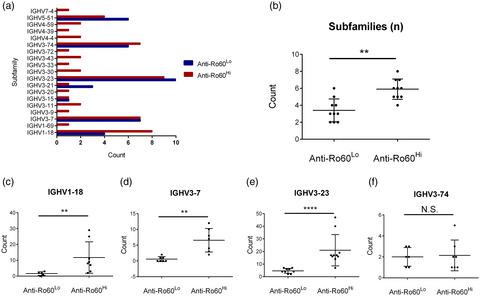当前位置:
X-MOL 学术
›
Clin. Exp. Immunol.
›
论文详情
Our official English website, www.x-mol.net, welcomes your
feedback! (Note: you will need to create a separate account there.)
Identification of a unique anti-Ro60 subset with restricted serological and molecular profiles.
Clinical & Experimental Immunology ( IF 3.4 ) Pub Date : 2020-08-27 , DOI: 10.1111/cei.13508 A Y S Lee 1, 2 , D Beroukas 1, 2 , L Brown 1 , C Lucchesi 1 , A Kaur 1 , L Gyedu 1 , N Hughes 1 , Y H Ng 1 , O Saran 1 , T P Gordon 1, 2 , J J Wang 1, 2
Clinical & Experimental Immunology ( IF 3.4 ) Pub Date : 2020-08-27 , DOI: 10.1111/cei.13508 A Y S Lee 1, 2 , D Beroukas 1, 2 , L Brown 1 , C Lucchesi 1 , A Kaur 1 , L Gyedu 1 , N Hughes 1 , Y H Ng 1 , O Saran 1 , T P Gordon 1, 2 , J J Wang 1, 2
Affiliation

|
Anti‐Ro60 is one of the most common and clinically important serum autoantibodies that has a number of diagnostic and predictive capabilities. Most diagnostic laboratories report this simply as a qualitative positive/negative result. The objective of this study was to examine the clinical and serological relevance of a novel subset of anti‐Ro60 in patients who display low levels of anti‐Ro60 (anti‐Ro60low). We retrospectively identified anti‐Ro60 sera during a 12‐month period at a major immunopathology diagnostic laboratory in Australia. These all were anti‐Ro60‐precipitin‐positive on the diagnostic gold standard counter‐immuno‐electrophoresis (CIEP). Lineblot immunoassay was used to stratify patients into either anti‐Ro60low or anti‐Ro60high subsets. We compared the medical and laboratory parameters associated with each group. Enzyme‐linked immunosorbent assay (ELISA) and mass spectrometry techniques were used to analyse the serological and molecular basis behind the two subsets. Anti‐Ro60low patients displayed less serological activity than anti‐Ro60high patients with less intermolecular spreading, hypergammaglobulinaemia and less tendency to undergo anti‐Ro60 isotype‐switching than anti‐Ro60high patients. Mass spectrometric typing of the anti‐Ro60low subset showed restricted variable heavy chain subfamily usage and amino acid point mutations. This subset also displayed clinical relevance, being present in a number of patients with systemic autoimmune rheumatic diseases (SARD). We identify a novel anti‐Ro60low patient subset that is distinct from anti‐Ro60high patients serologically and molecularly. It is not clear whether they arise from common or separate origins; however, they probably have different developmental pathways to account for the stark difference in immunological maturity. We hence demonstrate significance to anti‐Ro60low and justify accurate detection in the diagnostic laboratory.
中文翻译:

鉴定具有受限血清学和分子特征的独特抗 Ro60 子集。
抗 Ro60 是最常见且临床上最重要的血清自身抗体之一,具有多种诊断和预测能力。大多数诊断实验室仅将其报告为定性阳性/阴性结果。本研究的目的是检查抗 Ro60 新型子集在抗 Ro60 水平低(抗 Ro60低)的患者中的临床和血清学相关性。我们在澳大利亚一家主要免疫病理学诊断实验室回顾性鉴定了 12 个月期间的抗 Ro60 血清。根据诊断金标准对向免疫电泳 (CIEP),这些样本均呈抗 Ro60 沉淀素阳性。使用 Lineblot 免疫分析将患者分为低抗 Ro60 亚群或高抗 Ro60 亚群。我们比较了与每组相关的医学和实验室参数。使用酶联免疫吸附测定(ELISA)和质谱技术来分析这两个亚群背后的血清学和分子基础。抗Ro60低的患者比抗Ro60高的患者表现出更少的血清学活性,与抗Ro60高的患者相比,分子间扩散更少,高丙种球蛋白血症和经历抗Ro60同种型转换的倾向更小。抗 Ro60低亚群的质谱分型显示可变重链亚家族的使用和氨基酸点突变受到限制。该子集还显示出临床相关性,存在于许多患有系统性自身免疫性风湿病(SARD)的患者中。我们确定了一个新的抗 Ro60低患者亚群,其在血清学和分子水平上与抗 Ro60高患者不同。 目前尚不清楚它们是来自共同的起源还是不同的起源;然而,它们可能有不同的发育途径来解释免疫成熟度的明显差异。因此,我们证明了抗 Ro60低的重要性,并证明在诊断实验室进行准确检测是合理的。
更新日期:2020-08-27
中文翻译:

鉴定具有受限血清学和分子特征的独特抗 Ro60 子集。
抗 Ro60 是最常见且临床上最重要的血清自身抗体之一,具有多种诊断和预测能力。大多数诊断实验室仅将其报告为定性阳性/阴性结果。本研究的目的是检查抗 Ro60 新型子集在抗 Ro60 水平低(抗 Ro60低)的患者中的临床和血清学相关性。我们在澳大利亚一家主要免疫病理学诊断实验室回顾性鉴定了 12 个月期间的抗 Ro60 血清。根据诊断金标准对向免疫电泳 (CIEP),这些样本均呈抗 Ro60 沉淀素阳性。使用 Lineblot 免疫分析将患者分为低抗 Ro60 亚群或高抗 Ro60 亚群。我们比较了与每组相关的医学和实验室参数。使用酶联免疫吸附测定(ELISA)和质谱技术来分析这两个亚群背后的血清学和分子基础。抗Ro60低的患者比抗Ro60高的患者表现出更少的血清学活性,与抗Ro60高的患者相比,分子间扩散更少,高丙种球蛋白血症和经历抗Ro60同种型转换的倾向更小。抗 Ro60低亚群的质谱分型显示可变重链亚家族的使用和氨基酸点突变受到限制。该子集还显示出临床相关性,存在于许多患有系统性自身免疫性风湿病(SARD)的患者中。我们确定了一个新的抗 Ro60低患者亚群,其在血清学和分子水平上与抗 Ro60高患者不同。 目前尚不清楚它们是来自共同的起源还是不同的起源;然而,它们可能有不同的发育途径来解释免疫成熟度的明显差异。因此,我们证明了抗 Ro60低的重要性,并证明在诊断实验室进行准确检测是合理的。











































 京公网安备 11010802027423号
京公网安备 11010802027423号